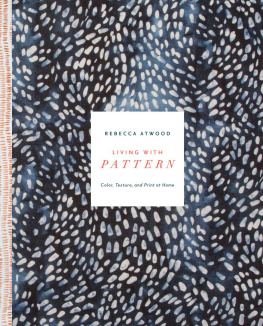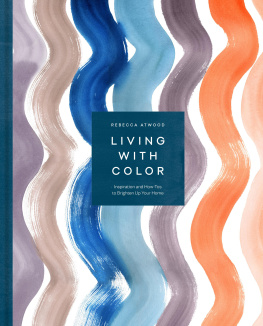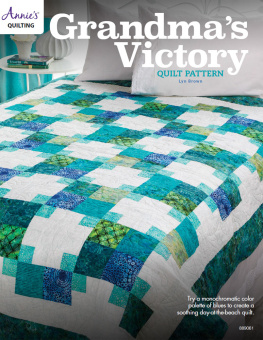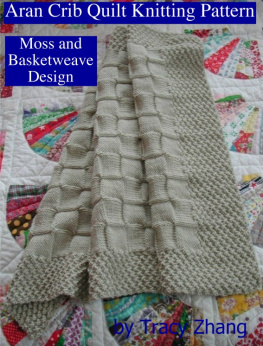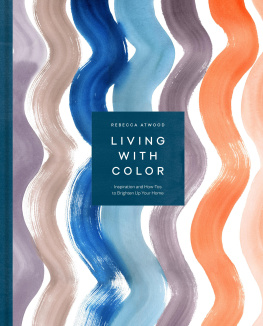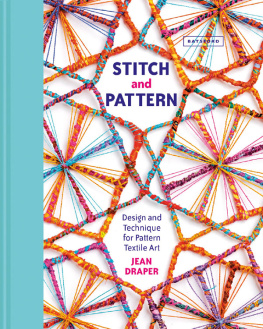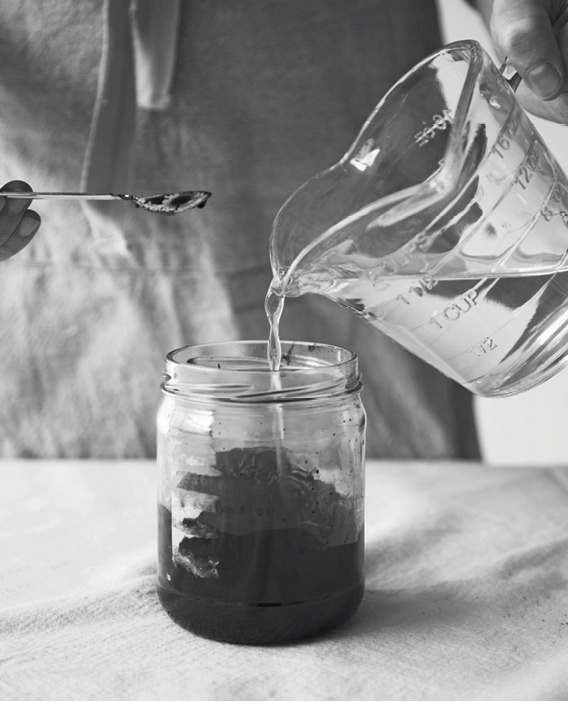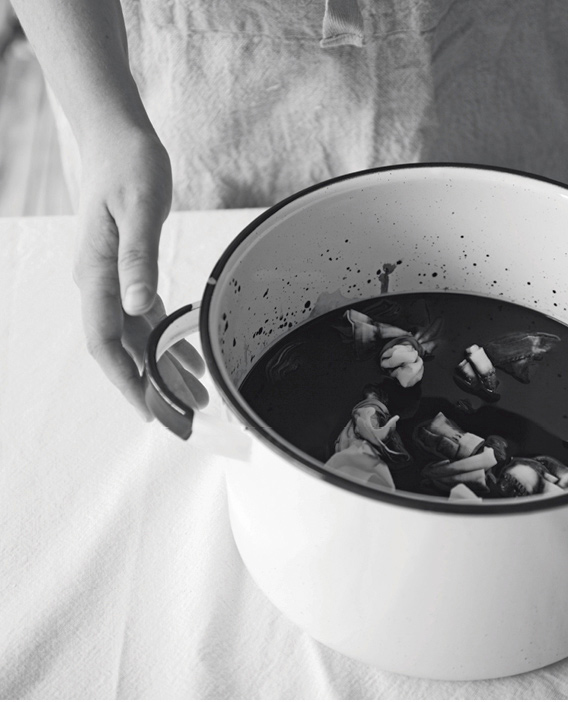Contents
PROJECT RESOURCES
DYEING FABRIC
Dyeing fabric is a great tool for customization, and while it may seem intimidating at first, its actually quite achievable once you understand the basics. Choosing the right dye depends on the fabric youre working with. Natural fibers such as cotton, linen, and wool require different dyes than protein fibers like silk, and synthetic fibers use yet another type. I work with procion fiber-reactive dyes, as there is no better dye for natural fabrics, which is my preferred fiber. They come in a wide range of colors and are colorfast as well as economical, safe, and easy to use. All-purpose commercial dyes, such as Rit Dye, are mixtures of different kinds of dyes and will work on a range of materials; they are meant for dyeing fabrics with a blend of fibers. If youre dyeing just one type of fiber, youll see the best results choosing a dye specified for it.
Ive included dyeing instructions for both fiber-reactive dyes as well as all-purpose dyes. I do highly recommend using the fiber-reactive dyes, especially for shibori styles, as the pattern will not bleed over time and you will see better results overall.
Regardless of the type of dye you choose, always wear rubber gloves and an apron or old clothes. Both dyes are considered nontoxic, but they are still chemicals, so you should use common sense and avoid inhalation (as you would with any fine powder). Please use separate containers or measuring utensils than those you use for cooking and eating. You can measure out the water in a measuring cup you already have and mix the dye in a recyclable plastic container. For further safety instructions, please read the information that comes with your dye of choice.
SHOPPING RESOURCES
AMAZON
www.amazon.com
DHARMA TRADING CO.
www.dharmatrading.com
PRO CHEMICAL & DYE
www.prochemical.com
SCOURING FABRIC
Prior to dyeing, thoroughly clean, or scour, your fabric so that the dye can take hold. It should be scoured with soda ash, which is essentially a very strong detergent; in a pinch, regular detergent will work on many fabrics, but it may not yield the best results. You can scour fabric on the stovetop or in the washing machine, depending on the amount of fabric. If scouring on the stovetop, place the fabric in a pot with water and approximately 1 tablespoon (12g) of soda ash plus a few drops of Synthrapol soap. Bring to a boil, reduce the heat, and allow to simmer for about 1 hour. Carefully drain and rinse the fabric thoroughly. If using a washing machine, put the soda ash in with the fabric and use the hottest water setting. Pour in about 1 tablespoon (14ml) of Synthrapol where liquid detergent goes.
DYEING WITH PROCION FIBER-REACTIVE DYES
SUPPLIES
Fabric
Pot or washing machine for scouring
Measuring cups and spoons
Soda ash (for fiber reactive)
Synthrapol (pH-balanced soap)
Dye in your choice of color
Various sizes of recyclable plastic or glass containers for mixing dyes (choose a size appropriate for the scale of the project)
Container for soaking and dyeing fabric (choose a size appropriate for the scale of the project)
Salt (if using all-purpose dye)
Vinegar (if using all-purpose dye)
Rit Color Stay Dye Fixative (if using all-purpose dye)
Apron or old clothes
Rubber gloves
Large spoon for stirring dye bath
Small spoon for mixing dye
STEP 1: Mix the Dye
Depending on the amount of fabric youre dyeing or the color youre trying to achieve, you may need to use more or less dye. About 1 tablespoon (7.5g) of powdered dye for 1 pound (450g) of fabric will result in a medium shade, but different dyes have different strengths, so be sure to read the labels. Its easiest to mix the dye if you first create a paste by adding a few drops of water to the powder in a recyclable plastic container. Then slowly mix the paste with 1 cup (240ml) of water. Be sure it is mixed thoroughly, otherwise you may end up with spots of various hues.
FIG. 1
STEP 2: Prepare the Fabric
Soak your scoured fabric in water; the temperature doesnt matter. It will dye more evenly if the fabric is wet prior to being placed in the dye bath.
STEP 3: Prepare the Dye Bath
Pour the prepared dye into a container large enough for the fabric to move freely and with enough room for it to be stirred without spilling. Add enough room-temperature water to your prepared dye that your fabric will be covered when placed in the dye bath. Stir the dye bath and then add your fabric. The recommended amount is 2 gallons per pound (9.5L per 450g) of fabric; use less if your fabric is covered by the dye bath and you want a deeper color (and vice versa). For even results, stir the fabric continuously; if you prefer a more irregular look, leave it be.
FIG. 2
STEP 4: Add the Fixative
Soda ash sets the color; without it, the dye will not be permanent. For 1 pound (450g) of fabric and a medium-strength color, use 5 tablespoons (60g) of soda ash. Dissolve it in 1 cup (240ml) of warm water. After the fabric has been in the dye bath for approximately 10 minutes, briefly remove the fabric from the dye bath, wearing gloves, and mix in the dissolved soda ash. Replace the fabric and stir occasionally. After approximately 60 minutes, take out the fabric.
STEP 5: Rinse and Wash the Fabric
Rinse the fabric under cool water until it runs clear, or soak it in a pot, changing the water until it runs clear. On the last rinse, add a drop or two of Synthrapol. Wash and dry the fabric in the machine separately at least once to remove any excess dye before mixing with your other laundry.
DYEING WITH ALL-PURPOSE DYES
STEP 1: Mix the Dye
You can buy premixed liquid dye; otherwise youll need to mix the powdered dye with water. Read the directions on the packaging for the recommended amount of dye per pound.
STEP 2: Prepare the Fabric
Soak your scoured fabric in water; the temperature doesnt matter. The fabric will dye more evenly if it is wet prior to being placed in the dye bath.
STEP 3: Prepare the Dye Bath
Pour the dye into a container large enough for the fabric to move freely and with enough room for it to be stirred without spilling. Then add enough hot water (140F [60C]) to cover the fabric. The recommended amount is 3 gallons per pound (11.4L per 450g) of fabric; but use less if your fabric is covered in the dye bath and you want a deeper color (and vice versa). Wait 5 minutes and then add the following to the dye bath:
FOR COTTONS: 1 cup (273g) of salt dissolved in 2 cups (480ml) of hot water
FOR SILK, WOOL, OR NYLON: 1 cup (240ml) of white vinegar
Once the dye bath is mixed, add the damp fabric. For even results, stir the fabric continuously; if you prefer a more irregular look, leave it be.
STEP 4: Rinse and Wash the Fabric
Rinse the fabric under cool water until it runs clear. I recommend letting it soak in a pot and changing the water until it runs clear. On the last rinse, add a drop or two of Synthrapol. I always suggest washing and drying the fabric in the machine separately at least once before mixing with your other laundry to remove any excess dye.
Please note that all-purpose dyes are often not as colorfast as fiber-reactive dyes, and bleeding may occur. You may want to use an additional fixative, such as Rit Color Stay Dye Fixative, if you choose to use all-purpose dye. Please follow instructions on the bottle.

